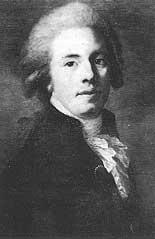Related information
Elhuyar Fundazioa
Fausto Fermin Elhuyar Zubize was born in Logroño on October 11, 1755. His father, Joan Elhuyar, was a prestigious surgeon, born in Hazparn and competent in the operation of cataracts of the eye. People came to heal from many places. He died as his mother the little Ursula of Donibane Lohizune and his older brother Juan José and his younger sister Maria Lorentza married again.
In 1772, his father sent to Paris with his brother Fausto to study. As his brothers worked mostly in chemistry and mineralogy. In 1778, a year after his brother Juan José, he began to work in the laboratory of the Royal Seminary of Bergara, but soon the two brothers returned to Europe (Paris, Strasburg, Mannheim, Freiburg, Leipzig, etc.) to learn the latest metallurgical techniques.
After touring Austria and Hungary in 1781, in October he returned to Bergara, while his brother John Joseph went to Sweden. In Bergara Fausto applied a third of its endowment to a mineral from Saxony, from the tin mines of Zinnwald, on the border of Bohemia and Saxonia. From 1782 he rehearsed with his brother Juan José.

Ore decomposition and extraction of iron and manganese. By treating the resulting residue with nitric acid the white precipitate is obtained. Subsequently, combined with hydrochloric acid, a yellow precipitate (tungsten oxide VI) was obtained. For its reduction it was crushed and mixed with coal powder in an hour and a half at strong fire. It came out like a gray button. The fingers turned dusty, the larger the size of the needle's head. Wolfram is a chemical element, first isolated in the world in Bergara.
For the first time in the General Meeting of Vitoria-Gasteiz of the Royal Society of Friends of the People, founded by Xabier Maria Munibe and the Knights of Azkoitia, this main discovery was unveiled. The following year and probably in writing by Fausto, the Toulouse Academy of Sciences published the report of the discovery process. It was published in 1785 in England, in 1786 in Germany and later in Sweden.
Fausto Elhuyar, with his brother Joan José, tried to obtain tungsten alloys mixed with gold, platinum, silver, copper, smelting, etc.
Fausto traveled from Bergara to Germany and Hungary to learn the techniques devised by Baron Born to deal with mercury silver minerals. He also worked to bring technicians to America. In Vienna, on 16 October 1787, he married Joana Raabe and then wrote in French Dissertations métalurgiques, but unfortunately he has not reached us.
Back in Spain until 1788 he trained engineers and mining technicians, many Germans. He took them to Mexico to improve and restore their farms.
In 1792 he founded in Mexico the “Real Seminario de Minas”, the first school of engineers in the country. When in 1821 Augustine Iturbide, emperor of Mexico, arrived in America, Faust resigned from his post and returned to Spain. He organized the General Directorate of Mining of Spain and began the development of the geological map of Spain. He also studied the Asturian mines.
Director General of Minas and Director of the Mining School, he died in Madrid on January 6, 1833, with his only daughter Luisa in Havana.





